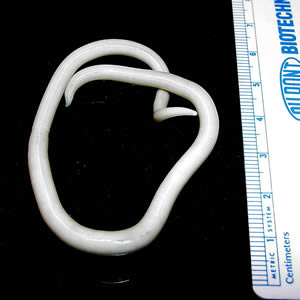
It has been estimated that less than 10% of global spending on health research is devoted to diseases or conditions that account for 90% of the global disease burden. These are mostly diseases of the world’s poorest people. The general public, and funding agencies, often equate third world diseases with the big three killers; HIV/Aids, tuberculosis and malaria. There is, however, a group of conditions known as neglected tropical diseases (NTDs) which have an even wider impact. They include some of the most common helminth parasites that, while don’t often kill, result in morbidity and debilitation. One of these, the large human roundworm Ascaris lumbricoides, is the focus of research by Professor Celia Holland at Trinity College Dublin.
A. lumbricoides infects over a billion people globally, mainly in tropical and sub-tropical regions. Infection occurs through the faecal-oral route. Poor sanitation results in soil becoming a reservoir for infectious eggs and ascaris is included within the group known as soil-transmitted helminths or geohelminths. This is why, sometimes, the salad is not the safest bet. Once swallowed the infective ova hatch in the small intestine. From the small intestine they migrate to the proximal colon, through the mucosa and onto the liver and eventually the lungs. In the lungs they penetrate the alveolar space, move into the pharynx where they are swallowed and returned back to the small intestine. The migratory route of ascaris and other related helminths may be an evolutionary holdover from a skin penetrating ancestor.
The discovery of the ascaris life cycle in humans is one of those great anecdotes that pepper medical history. In 1922 Japanese paediatrician, Shimesu Koino, infected both a volunteer and himself with ascaris eggs. He realised the larvae were migrating when he found large numbers of larvae in his sputum. Put plainly, he coughed up baby nematodes that had penetrated his lungs. Not a methodology likely to get past ethics committees today.
Worldwide, severe ascaris infections cause approximately 60,000 deaths per year, with serious health consequences observed in a further 122 million people. Children from preschool age to adolescents carry the greatest worm burdens. Ascariasis is the disease associated with ascaris infection and symptoms include appetite loss, lactose maldigestion and impaired weight gain. As children are at vulnerable stages of growth and development, these nutritional deficits lead to stunted growth, diminished physical fitness and impaired memory and cognition. Other symptoms of adult worms include abdominal distension and pain, nausea and diarrhoea. In heavy infections entangled worms have been known to cause intestinal blockages. The migrating larvae cause their own set of problems which include acute lung inflammation, difficulty in breathing and fever.
Ascariasis and other neglected infectious diseases are diseases that result from poverty but also help to perpetuate it. Children cannot develop to their full potential, and infected adults are not as productive as they could be. The good news is that there is a renewed momentum in combating these diseases. The World Health Organization (WHO), and public-private partnerships are linking their efforts to combat NTDs in a more coordinated and systematic way. The Bill and Melinda Gates Foundation have to date committed more than US$1.02 billion in grants to organizations working to address NTDs and have named ascaris as one of their newly targeted diseases. The WHO has set out a strategy for eliminating morbidity from soil transmitted helminths in children by 2020.
This makes Professor Holland’s new book “Ascaris: The Neglected Parasite”, a timely and important contribution to the fight against NTDs. The book is the first on ascaris in over 20 years and presents a wealth of new insights. The 16 chapters from top authors from around the world include detailed information on the biology, epidemiology, host and parasite genetics and public health and clinical aspects of A. lumbricoides and the closely related A. sum, an economically important parasite of pigs. As any researcher new to a field knows, having up to date research collected and summarised in an assessable format, with lists of lovely, lovely references, is a gift. This is the third book Professor Holland is senior editor on, the others being “Toxocara the enigmatic parasite” and “The Geohelminths: Ascaris, Trichuris and Hookworm”.
Author
Karen Loxton: loxtonk[at]tcd.ie
Photo credit
Wikimedia commons

